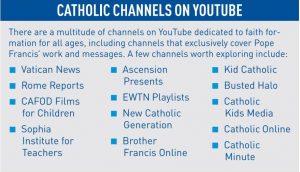
Tips for sharing safe, distraction-free video content
ANNABEL DOTZMAN
In our ever-changing world, technology continues to develop at a record pace. If we stop for a moment to reflect on the ways it affects our daily lives, we may be surprised to realize the enormity of its far-reaching effects. From work and play to everything in between, technology is there. We actually may be hard-pressed to name a handful of activities that we do on a daily basis that do not involve any sort of technology; there
is almost no escaping it. In fact, today’s youth are being labeled as “digital natives” — that is, a generation that always has been surrounded by and interacted with technology.
 Within any given school year, educators curate tremendous amounts of material, with the
Within any given school year, educators curate tremendous amounts of material, with the
goal of developing or updating lessons that will engage their students and result in meaningful learning. The internet provides educators with much easier access to a wide range of digital tools to assist in accomplishing this goal. In particular, multimedia platforms have the capability of addressing multiple learning modalities and give students access to nearly all content available at their learning level. One such platform that may
not be the first tool catechists, especially those working with younger age groups, reach out to is YouTube (YouTube.com). Yet YouTube videos can be an engaging and effective resource for faith-based instruction.
Keeping unsuitable content away from children
Oftentimes, comments, ads, and video suggestions that appear around a particular video may not be suitable for a class setting. As a result, educators might become hesitant to incorporate these videos into lessons and share them with their students. But what if there was a way to eliminate the distractions that tend to be inherent with YouTube videos?
View Pure (ViewPure.com) and Video Link (Video.link) are two free and easy ways to do just that. These websites take away all the distractions and allow educators to share videos safely with their students. Both platforms use a YouTube video link to display videos in a simple, clean format. Cropping features in both sites give catechists the flexibility to show only portions of the selected video. These sites make it manageable
to share YouTube videos safely in the classroom, thus enabling the content to be a valuable resource for engaging students with multimedia. (See demonstrations of these applications
here: youtu.be/VJfSzMU12DE.)
While these tools provide an effective means of utilizing videos, a recommended best practice is to always preview any channel content prior to sharing them with students. This will ensure that the topics and videos selected are appropriate and best suited for the intended audience. Common Sense Media’s educators’ resource page is another valuable resource for both educators and parents (find it at CATmag.us/2LiRKrl). Through this site, catechists can locate additional tips and strategies on effectively integrating videos into their lessons. By integrating digital tools where possible and by rethinking traditional instructional approaches, catechists can design authentic learning activities that maximize active, deep learning.
Annabel Dotzman, MEd, is a technology integration coach, PreK-12, for the Archdiocese of Philadelphia, and a former classroom teacher. She is part of a team providing training and support to archdiocesan educators for the integration and best-practice use of educational technology across the curriculum.
This article was originally published in Catechist magazine, October 2018
Photo: ozgurdonmaz, istock




